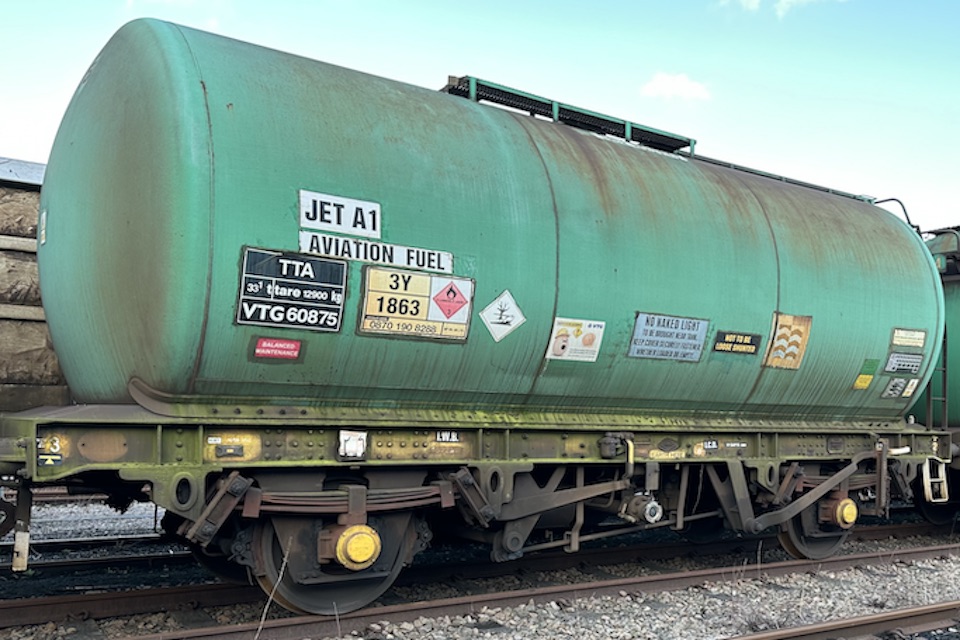Tanker wagons roll into UK history

Four wheels on my wagon. A rake of historic two-axle tank wagons has just been retired from active service. They were moved on their last trip from Scotland to the MCL Group sidings near Selby in Yorkshire. However, they are not destined for the breakers yard. At least a rake of ten will be saved for preservation and demonstration workings, being pulled by the sort of traction that was state of the art when these wagons were delivered to the network.
The wagons end their life in the dawn of the digital age, but they began it in the twilight of the steam age. These are very likely the last examples of goods rolling stock designed for a time before the moon landings – although they may still have a starry role to play in the future. A preservation society intends to restore the wagons for use in an impressive demonstration goods train, as the star attraction at a heritage railway in England. In their working life, the wagons were used for transporting high-octane aviation fuel.
Forerunners of modern designs
Two axle tank wagons were once a common sight on the British railway network. The standard designs were adapted to carry everything liquid, from agricultural cold milk to industrial hot tar. “Oil based freight has been a massive business for the railways second only to coal”, says the National Wagon Preservation Group, a specialist association that plans to purchase ten examples fo the wagons from the rake of twenty-two currently stored at Gascoigne Wood, in the yard of MCL Group, the specialist rolling stock storage and maintenance contractors.
The launch of monobloc four wheel tanks in the early 1960’s started production runs which totalled many thousands, say the NWPG. They were utilised by all the big oil refining companies, and are the forerunners of the modern, larger, bogie-mounted wagons common today. “This developed into the bogie [TEA designated] tanks which became the industry standard and started the slow decline of the four wheel TTA’s.”
Demonstration freight trains
The NWPG has owned a single TEA four-wheel wagon for several years. It has been stored awaiting a home, which now looks likely to be the Dean Forest Railway, a popular tourist operation in the south west of England. The heritage railway is working in partnership with the NWPG to raise a fund of around 35,000 pounds (41,000 euro) to purchase the rake. “The NWPG has launched an appeal to rescue up to 10 TTA tanks from scrap”, says the NWPG . The scrap merchant has agreed to allow the NWPG some time to raise monies to save the wagons.”
If successful, the wagons will have a new lease on life, very much in the public eye. In partnership with the Dean Forest Railway, the NWPG house the wagons at the railway, where they will carry out maintenance and repair, ahead of intended plans for use at the DFR. The operation of demonstration freight trains is a popular attraction and revenue stream for heritage railways in the UK. Among their uses are for timetabled runs, photographic opportunities, and driving experience days.
GBRf simulator drive offered as prize
According to the enthusiast group, often wagons are overlooked in preference for preservation of locomotives and coaches that provide revenue earning service for heritage railways. “Typically, wagons have a shorter life span than locomotives and passenger stock”, say the group. “En-masse scrapings over a short period of time have seen entire classes of wagons disappear for good.The NWPG are looking to turn this around, not only preserving these historically important pieces of rolling stock but also to create detailed histories of the wagons.”

Appropriately enough, the wagons were delivered from Grangemouth in Scotland, hauled by a pair of class 37 diesels, of about the same vintage as the wagons. They arrived at Gascoigne Wood in mid-November last year. As an incentive to help fundraising, the rail freight operator GBRf has generously offered a prize opportunity for a lucky contributor to drive on their simulator at their recently opened offices in Peterborough. An experience for which to say: “Tanks for the memory.”
You just read one of our premium articles free of charge
Want full access? Take advantage of our exclusive offer





